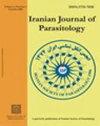牛巴贝西亚种的流行和分子特征以及克什米尔喜马拉雅山牛巴贝西亚的首次报告
IF 0.9
4区 医学
Q4 PARASITOLOGY
引用次数: 0
摘要
背景:克什米尔山谷属于温带气候,而印度其他地区属于热带和亚热带气候,因此我们认为有必要对这一全球性疾病--牛巴贝西亚原虫病进行研究。研究方法为了对临床疑似牛(450 头)进行巴贝西亚原虫病诊断,我们进行了外周血片检查,并使用通用引物和物种特异引物,分别针对巴贝西亚/泰勒利亚属、比格米纳巴贝西亚原虫、牛巴贝西亚原虫和分歧巴贝西亚原虫进行了 PCR 检测。对四个 PCR 产物进行了测序和 BLASTn 分析。从临床疑似动物身上采集蜱虫,并根据标准形态学指标进行鉴定。结果通过外周血片检查和 PCR 技术,克什米尔中部疑似牛的巴贝西亚原虫感染率分别为 11.11% 和 33.62%。巴贝西亚原虫 B1 体系的 18S rRNA 基因与 GenBank 中登记的不同 B. bigemina 分离物的 18S rRNA 基因的核苷酸序列同源性为 99.0%至 100%,而 Z 体系的 18S rRNA 基因与 GenBank 中登记的不同巴贝西亚原虫和 B. bigemina 分离物的 18S rRNA 基因的核苷酸序列同源性分别为 98.5%至 99.2%和 93.1%至 93.9%。Rhipicephalus spp.和 Haemaphysalis spp.是本研究中发现的两个主要蜱属。结论克什米尔的牛巴贝西亚原虫病是由 B. bovis、B. bigemina 和其他一些巴贝西亚原虫属或菌株引起的,需要进一步调查。据我们所知,这是印度北部首次报告牛巴贝斯虫病。本文章由计算机程序翻译,如有差异,请以英文原文为准。
The Prevalence and Molecular Characterization of Bovine Babe-sia Species and the First Report of B. bovis from Kashmir Himalayas
Background: Bovine babesiosis, a global disease, has not been studied so far in Kashmir valley, which is having temperate type of climate as compared to rest of India having tropical to sub-tropical climate, so we felt the need to investigate it.
Methods: To diagnose the babesiosis in clinically suspected cattle (n=450), peripheral blood film examination and PCR tests using generic and species-specific primers targeting Babesia/Theleria genera and B. bigemina, B. bovis as well as B. divergens, respectively were conducted. Four PCR products were sequenced and subjected to BLASTn analysis. Ticks were collected from the clinically suspected animals and identified as per the standard morphological keys.
Results: The prevalence of babesiosis among suspected cattle in central Kashmir by peripheral blood film examination and PCR technique was 11.11% and 33.62%, respectively. The 18S rRNA gene of Isolate B1 of Babesia spp. showed 99.0 to 100% nucleotide sequence homology with 18S rRNA gene of different isolates of B. bigemina registered in the GenBank, while as 18S rRNA gene of Isolate Z showed 98.5 to 99.2% and 93.1 to 93.9% nucleotide sequence homology with 18S rRNA gene of different isolates of Babesia spp. and B. bigemina, respectively, registered in the GenBank. Rhipicephalus spp. and Haemaphysalis spp. were the two major tick genera identified in the present study.
Conclusion: Bovine Babesiosis in Kashmir is attributed to B. bovis, B. bigemina and some other Babesia spp. or strains which needs further investigation. To our knowledge, this is the first report of Babesia bovis from northern India in cattle.
求助全文
通过发布文献求助,成功后即可免费获取论文全文。
去求助
来源期刊

Iranian Journal of Parasitology
PARASITOLOGY-
CiteScore
1.80
自引率
0.00%
发文量
55
审稿时长
6-12 weeks
期刊介绍:
Iranian Journal of Parasitology (IJP) is the official publication of Iranian Society of Parasitology (ISP) launched in 2006. The society was inaugurated in 1994 and pursues the improvement of the knowledge on the parasites and parasitic diseases, exchange of scientific knowledge with foreign societies, publicity activities, and consultation on the parasitic diseases, and intimate relationship among society members.
The main aims of the Journal are: contribution to the field of Parasitology, including all aspects of parasites and parasitic diseases (medical and veterinary) and related fields such as Entomology which may be submitted by scientists from Iran and all over the world.
 求助内容:
求助内容: 应助结果提醒方式:
应助结果提醒方式:


